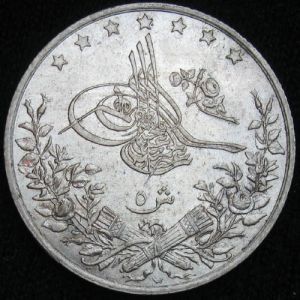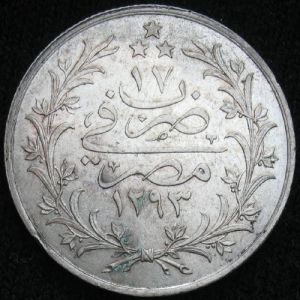Egypt AH 1293(17)-W 5 qirsh
The coin shown is a five qirsh, composition silver, from the reign of Sultan Abdul Hamid II. The obverse bears the toughra, or signature, of the sultan, with the denomination written below. A flower design is to the right of the toughra. The mintmark W is at the base, and stands for designer Emil Weigand, Berlin Mint. The reverse carries the year of mintage (year 17 of reign) followed by the script minted in Misr (Arabic for Egypt). The year of accession (1293) is written below, and all the foregoing is enclosed by a wreath. The date of the coin translates to 1891 AD. Uslu[1] lists this issue as scarce.
This denomination represents a member of a coinage reform started in 1884 AD. Previous to that date, coins with a value less than one qirsh were given in the unit 'para'. Though fractional qirshes were treated differently than previous years, qirshes and their multiples resembled pre-reform designs and compositions. The difference was the introduction of copper-nickel qirshes in certain years. This suite of denominations was continued until the collapse of the Ottoman Empire, and subsequent loss of influence in Egypt, in 1914 AD.
Recorded mintage: unknown.
Specifications: 7.0 g, 0.833 silver.
Catalog reference: KM 294.
- Michael, Thomas, and Tracy L. Schmidt, Standard Catalog of World Coins, 1801-1900, 9th ed., Iola, WI: Krause Publications, 2019.
- [1]Uslu, Kaan, Beyazit, M. Fatih, and Kara, Tuncay, Ottoman Empire Coins, Istanbul: Mas Matbaacilik A.S., 2007.
Link to:

